One of the questions I am frequently asked is where the Beautiful Gate of the Temple was located. This gate is mentioned in the New Testament (Acts 3.2,10) as the place where the lame man was begging. After he was healed by Peter and John “he went with them into the temple courts, walking and jumping, and praising God” (Acts 3.8).
The “Beautiful Gate” is not mentioned in other historical sources. Many scholars have accepted Thackeray’s comment on Josephus’ description of the Nicanor Gate, or the Corinthian Gate as he called it (War 5.201,204), that it “probably” was the gate of Acts 3.2,10. Edersheim was of the same opinion.
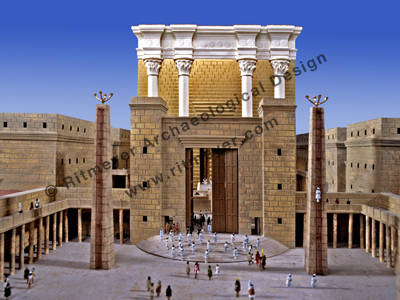
The Nicanor Gate (Middot 1.4, 2.3,6; Yoma 3.10, etc.) was certainly beautiful, but the question is, would the lame man have been allowed to enter so far into the Temple Courts? This appears not to have been the case, as once he was healed, he entered into the Temple Courts (Acts 3.8), so the Nicanor Gate could not have been the Beautiful Gate. According to Acts 3.11 the healed man and Peter and John were in Solomon’s Porch, which is to the east of the Court of the Women.
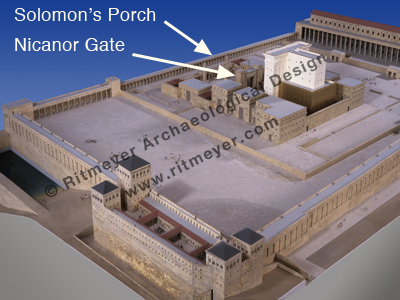
Others have suggested that the Beautiful Gate must have been one of the outer gates of the Temple Mount. Because of its proximity to Solomon’s Porch, some have suggested that the Shushan Gate in the Eastern Wall of the Temple Mount, may have been the Beautiful Gate, as it had a beautiful representation of Shushan the Palace (Middot 1.3).
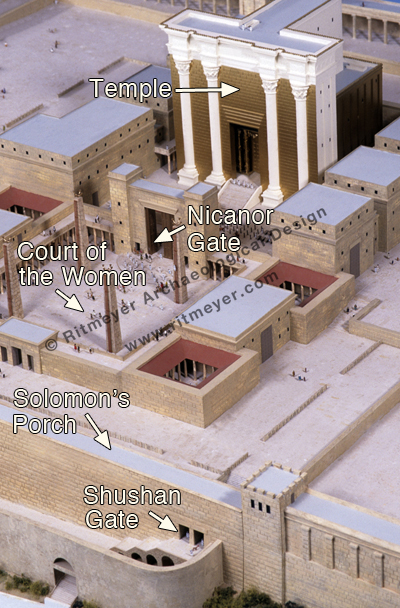
According to Mishnah Kelim 1.8, nobody with an issue of any kind was allowed into the Temple Mount. Although the lame man need not have had an issue, his infirmity may have put him in the same category. Another point to consider is the fact that he was begging. To get the best results, one would want to be where the traffic was greatest, which is another argument which would rule out the Nicanor Gate, as not many people were allowed to go through this gate. It would also rule out the Shushan Gate, which was mainly used for ceremonial purposes.
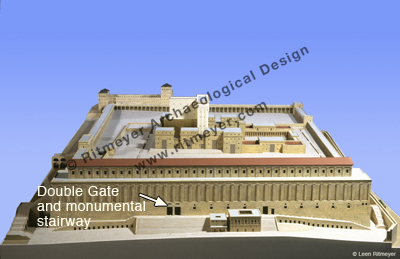
A more likely location would have been the Double Gate in the southern wall of the Temple Mount, which I have described in my book The Quest, Revealing the Temple Mount in Jerusalem, pp. 67-74. A 210 feet (64 m) wide monumental stairway led up to this gate from the lower plaza. Because of its monumental proportions, this gate was probably used by most of the pilgrims going to worship at the Temple.
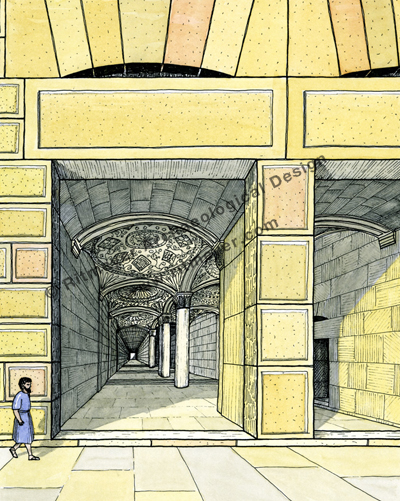
The ceiling inside the passageway has beautifully carved domes, which have survived up to today. Most of the worshipers went up to the Temple Courts through this gate, which was certainly beautiful and very effective for begging purposes, as suggested on p. 74 of the above mentioned book.
We suggest then that Peter and John healed the lame man at the Double Gate and from there he went “walking and jumping” to Solomon’s Porch.

Very good article. One question:
You mention that, “To get the best results, (a beggar) would want to be where the traffic was greatest, which is another argument which would rule out the Nicanor Gate, as not many people were allowed to go through this gate.”
While the Nicanor gate certainly would not have had much traffic (comparatively speaking), can an argument be made that the traffic present at this gate was the most “affluent”, as the treasury for monetary offerings was located in the Court of the Women, and thus those who were present there would, in theory, have the most money to give a beggar?
Thanks much for all of your work!
james miller
Thanks for this valuable insight. I had also heard a possible identification of the Beautiful Gate was the eastern Golden Gate (or same location). Also, I thought the double gates of the Southern Steps were the exit . . . while the triple Hulda gates were the entrance to the Temple Courts. Thanks again.
James,
If the beggar was already in the Court of the Women where the Nicanor Gate is located, why does it say that after he was healed he entered into the Temple Courts? He must have been outside the Temple Courts, as, because of his infirmity he most likely wasn’t allowed in anyway.
There was very little traffic through the Nicanor Gate. It was used by the Levitical Choir, and for ceremonies such as the suspected adulteress and the healed lepers. Apart from that Israelite males could go into the Court of the Israelites, which they mainly did at Passover. Most of the priests would have entered the Temple Courts through the many side gates that surrounded the Temple and I have my doubts about their generosity in the light of the parable of the Good Samaritan.
Wayne,
The Shushan Gate stood where the Golden Gate is located today and I have discussed the possibiltiy that it might have been the Beautiful Gate in my post. The information about entry and exit through the Huldah gates comes from Middot 1.3: “two Huldah Gates on the south, that served for coming in and for going out”. As Middot only relates to the 500 cubit square Temple Mount, it does not refer directly to the Double and Triples Gate, of which we do not know their original names. The Double Gate double passageway would, however, have exited opposite the Huldah Gates.
There is interesting information about this circulation in Middot 2.2, where it says that people entered on the right and exited through the left gate. Ad the Double Gate was used by most worshipers, I believe that the eastern gate of the Double Gate was used for going in and the western for going out. However, if anything wrong had happened, one went in the opposite direction, so that he may be noticed and people could comfort the person. This would have been the ideal place for begging purposes. One of the blessings people would say was: “May He that dwells in this House give you comfort”. That certainly happened in the record of Acts 3.
Thanks for this valuable insight. I had also heard a possible identification of the Beautiful Gate was the eastern Golden Gate (or same location). Also, I thought the double gates of the Southern Steps were the exit . . . while the triple Hulda gates were the entrance to the Temple Courts. Thanks again.
Very good article. One question: You mention that, “To get the best results, (a beggar) would want to be where the traffic was greatest, which is another argument which would rule out the Nicanor Gate, as not many people were allowed to go through this gate.” While the Nicanor gate certainly would not have had much traffic (comparatively speaking), can an argument be made that the traffic present at this gate was the most “affluent”, as the treasury for monetary offerings was located in the Court of the Women, and thus those who were present there would, in theory, have the most money to give a beggar? Thanks much for all of your work! james miller
James, If the beggar was already in the Court of the Women where the Nicanor Gate is located, why does it say that after he was healed he entered into the Temple Courts? He must have been outside the Temple Courts, as, because of his infirmity he most likely wasn’t allowed in anyway. There was very little traffic through the Nicanor Gate. It was used by the Levitical Choir, and for ceremonies such as the suspected adulteress and the healed lepers. Apart from that Israelite males could go into the Court of the Israelites, which they mainly did at Passover. Most of the priests would have entered the Temple Courts through the many side gates that surrounded the Temple and I have my doubts about their generosity in the light of the parable of the Good Samaritan.
Marisol,
You are probably right saying that those passing through the Nicanor gate had most money to give, but would they – see my earlier reply to James.
Sharron,
See my reply to Wayne.
Wayne, The Shushan Gate stood where the Golden Gate is located today and I have discussed the possibiltiy that it might have been the Beautiful Gate in my post. The information about entry and exit through the Huldah gates comes from Middot 1.3: “two Huldah Gates on the south, that served for coming in and for going out”. As Middot only relates to the 500 cubit square Temple Mount, it does not refer directly to the Double and Triples Gate, of which we do not know their original names. The Double Gate double passageway would, however, have exited opposite the Huldah Gates. There is interesting information about this circulation in Middot 2.2, where it says that people entered on the right and exited through the left gate. Ad the Double Gate was used by most worshipers, I believe that the eastern gate of the Double Gate was used for going in and the western for going out. However, if anything wrong had happened, one went in the opposite direction, so that he may be noticed and people could comfort the person. This would have been the ideal place for begging purposes. One of the blessings people would say was: “May He that dwells in this House give you comfort”. That certainly happened in the record of Acts 3.
what is the size of the original herod’s double gate?
Elija,
It is about time that you start reading my book “The Quest – Revealing the Temple Mount in Jerusalem” 😉
Each gate is 5.00 m wide and 7.70 m. high and the Double Gate’s exterior width is 11.90 m.
Well i do appreciate your free response, and your free informative blog 🙂
here at
http://www.preteristarchive.com/Ancient_Revelations/pdf/1884_king_discoveries_temple_hill.pdf page 73
states that the width of the Double Gate is “5.4864 meters”
??
also claims that it’s the same as the balclay’s gate! how did he know that?
All these measurements were taken by Charles Warren, who investigated these underground structures below the Temple Mount in the 1860’s. I have also taken measurements inside the Double Gate, the Triple Gate, Solomon’s Stables and the Golden Gate and have found that Warren’s measurements were correct on most accounts.
well fellows i’m no researcher like you guys but i just want to say keep up the good work, at least for the sake of myself and other collegues who may be keen to know but not able to do much research staff.
Dear Dr Ritmeyer
Models and drawings of the Temple (including your own superb examples) tend to show the fifteen steps under the Nicanor Gate curving in a semi-circle out into the lower court, like a protruding hill. However, the Mishnah Middoth 2:5 says
And fifteen steps ascended from within [the Court of Women] to the Court of Israel, corresponding to the fifteen Songs of Ascents in the Psalms, and upon them the Levites stood in song. They were not straight but rounded (moqfot), like half a round threshing-floor (Mid. 2.5).
To me this rather suggests that they curved inward in a semi-circle beneath the great gate, like the wall of a recessed bowl, not outward like a small hill. For an ancient eastern threshing-floor is bowl-shaped not bump-shaped. Even if built on a hill – to catch the wind for winnowing – its has a perimeter wall to stop the grain being lost. This agrees with moqfot, which means not simply ‘curved’ but rather ‘encompassing’ or ‘surrounding’. Ascents Psalm 122, sung on these steps, says ‘Our feet are standing in your gates (not ‘in front of your gates’), Jerusalem.’ Likewise, Josephus tells of the ‘fifteen steps, which led away from the wall of the Court of Women to this greater gate’ which suggests that the steps began not in the courtyard, but at the wall, leading up inside the gateway (War, V.v.3). Such a shape would resemble an ancient Greek theatre or even, dare one say, the Hollywood Bowl. The acoustic advantages of such a structure would accord with its known function as the performing area of the Temple orchestra, while enabling musicians to see the chironomer and hear one another.
Is there any chance this ‘inward-curving theory’ could be right? Or is there solid architectural evidence against me?
Many thanks
Ok…so each entrance of the eastern gate is 5.00 meters wide, 7.70 meters high, with an exterior width of 11.90 meters? I want to do a 3d model of this gate. As for the overall exterior height from the ground to the top of the wall, what is that? And also the width of the gate from front to back? I’m very interested in producing an accurate model, inside and out, of this gate. So any help would be appreciated. I’ll just have to convert it all into feet, since I’m in the US, and we don’t use metric here much.